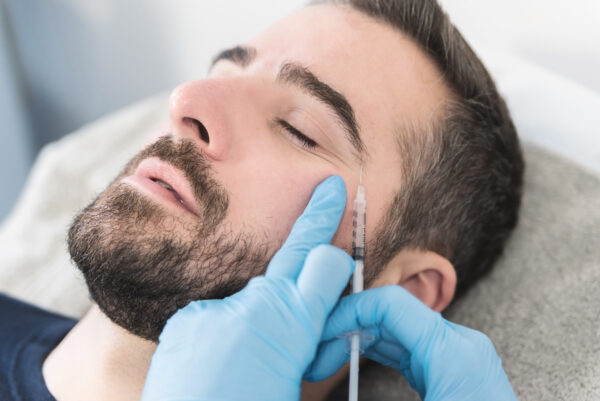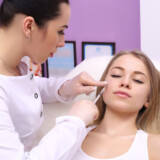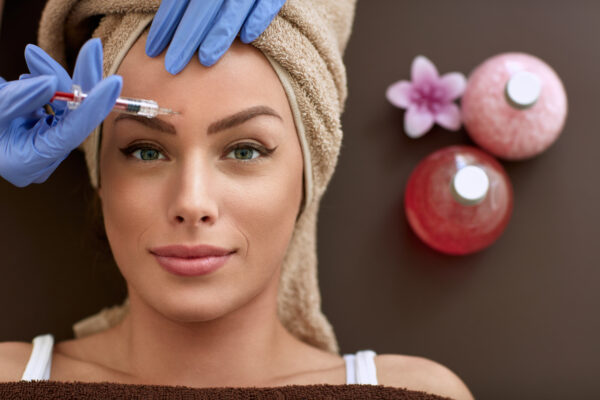Is it Possible for a Phlebotomist to Administer Injections?


Phlebotomists must spend further training, certification, and licensure in order to collaborate with dermatologists, plastic surgeons, and other aesthetic professionals.
Medical assistants with training in blood collection are known as phlebotomists. They might be permitted to collect other kinds of medical samples and carry out simple lab procedures in certain circumstances.
Depending on the situation, phlebotomists are under the direction of a registered nurse, a doctor, or another qualified medical practitioner. Though certification is required in most areas, the licensing process is typically less onerous for these professionals than it is for nurses, PAs, and MDs.
Patients, as well as providers unfamiliar with phlebotomy, frequently ask whether or not a phlebotomist can also administer injections.
Injectables: Can a Phlebotomist Do It?
In most cases, phlebotomists are not qualified to administer injections.
Phlebotomists receive specialized education and are typically licensed to do nothing but draw blood from patients.They are permitted to prepare and dress the treatment area and take blood for a virtually limitless number of medical examinations and procedures, but they are not permitted to administer any injections to the patient.
Phlebotomists may work with or report to aesthetic nurses or registered nurses who have completed specialized training to be able to provide injections. Additionally, in some circumstances, only specially trained phlebotomists may provide injections.
Work Responsibilities of a Phlebotomist
The primary duties of a phlebotomist include taking blood and other fluid samples from veins and preparing them for laboratory analysis. Some obligations include:
- educating patients about the treatment they will soon undertake
- taking precautions to prevent infection by prepping the skin around the drawing area
- locating a healthy vein for blood collection
- collecting blood
- preparing and organizing blood samples for delivery to a lab
- Cleaning and organizing the clinical spaces for which they are accountable
- taking care of any paperwork and data entry as necessary
Notably absent from this list is anything related to administering injections. Most phlebotomists lack the necessary credentials to administer injections. If this happens, the provider and their supervisor may face disciplinary action, regulatory action, or even legal action.
There may be exceptions to this rule for people who have received adequate training. Certified phlebotomists with additional training and education can do more for their patients, such as
- Blood collection from arteries, a more dangerous procedure than vein collection.
- Nursing duties including preparing and connecting IV drips
- Administering injections with a hypodermic syringe
Phlebotomy License and Education Requirements
State-by-state variations exist in phlebotomy license requirements. They are less extensive than those for nurses and other medical specialists, and a large portion of phlebotomists’ actual training takes place on the job.
Can a phlebotomist administer cosmetic treatments?
Phlebotomists are not qualified to administer Botox® or dermal fillers because such procedures call for specialized training and education. Even those who have received specialized training for injections will typically steer clear of performing subcutaneous procedures such as these and instead concentrate their efforts on administering intramuscular injections, such as vaccines.
Phlebotomists who are interested in working with dermatologists, plastic surgeons, and other aesthetic specialists are required to invest in additional education, certification, and licensing in order to do so.
Opportunities for Professional Advancement Open to Phlebotomists
Beginning their careers in the medical field as phlebotomists, a significant number of people eventually advance their careers to become nurses, physician assistants, or even physicians.
Becoming a registered nurse and then enrolling in master injector training through an accredited aesthetic medical education provider is the most straightforward route for individuals who are interested in administering cosmetic injections. Nurses-to-be learns how to administer a wide variety of injections, but the curriculum doesn’t drill down into the finer points of the methods and supplies used in non-invasive cosmetic procedures.
With Dentox, aesthetic specialists can learn how to inject Botox and dermal fillers in a safe and effective way. One of the most well-known injectable trainers in the country is Dr. Howard Katz. He offers his students a variety of learning options, including in-person, online, and on-demand classes. For access to online courses and live courses featuring actual patients, go to https://dentox.com/live-courses/ and https://dentox.com/all-courses/botox-training/, respectively.
When does Botox start to show results?


Botox has numerous uses in the medical and cosmetics industry.
Botulinum toxin type A (also known as Botox) is an injectable that has many applications in medicine and the cosmetics industry. It’s a nerve relaxant prescribed for a wide range of conditions wherein muscle contraction is the root cause of distress.
The fact that some people are still wary of giving Botox a try despite the fact that it has been available for quite some time may be attributable to the fact that they are unfamiliar with its basic operating principle. One of the most frequently asked questions is how long it takes for Botox to take effect, so let’s go over that. We are confident that you will agree that it is one of the best alternatives to invasive cosmetic procedures that leave permanent scars and require months of recovery time.
Essential facts regarding Botox injections
Allergan, the company that developed Botox, is responsible for producing injectable treatments containing botulinum toxin. An outpatient procedure uses tiny amounts of the solution to temporarily halt the aging process and the formation of wrinkles by relaxing the strong facial muscles and stopping their contractions.
Clostridium botulinum, from which botulinum toxin type A is derived, is a bacterium that, in large enough quantities, can be lethal. Though there may be some cause for concern, the amount of this component used in the production of Botox solutions is extremely minute.
Botox is sometimes used by medical professionals to remove wrinkles, creases, and other skin flaws that have already developed, such as frown lines, crow’s feet, and forehead lines. This is the best choice for dynamic lines because they are typically the first to occur because of rich facial expressions. Additionally, since the primary goal of every injection of botulinum toxin is to halt muscle contractions, dealing with the effects of active facial movements can be done with the help of this treatment.
How long does Botox take to work?
Typically, a patient will have to wait between three and five days after the initial treatment before noticing any improvement. One cannot see the full effect right away because it takes some time for the product to reach the nerve endings, actually freeze them, and smooth the “results” of their contractions. Several procedures should be carried out during the two weeks it takes for Botox to start working its magic:
- There should be no more bothersome effects or reactions (swelling, redness, bruising);
- If the treatment is to be effective, it must reach the nerves that will be affected.
- In time, your body’s natural processes should help erase the signs of aging, including fine lines and wrinkles.
For this reason, customers should be prepared to be patient as they await the noticeable results that Botox promises. And now that we’ve answered basic questions like “how does Botox work,” we can move on to discuss how long the effects may last at different injection sites.
Resilience in Many Areas
Here, we’d like to discuss how long the effects of a Botox injection last and how that varies by the area injected. Therefore, the three primary treatment areas are as follows:
- Wrinkles in the forehead. This situation might require multiple treatments. To achieve optimal results, a specialist should begin with a lower dosage and increase it over time. Two to three months is the anticipated durability for this zone;
- Crow’s feet. Because the skin is so delicate there, it may take a few days for the full effect to show up after an injection session. In most cases, once every four months is sufficient for this small area to receive a Botox injection;
- Perioral area. When treating lines around the mouth, the results can last anywhere from three to four months, though this will vary from person to person based on factors like age and skin type.
Once the Botox injections are administered, how long before you notice the effects?

When a week has passed, the effects of the Botox injection become most apparent.
There should be no functional distinction between treatment areas for Botox, provided that the injections are administered correctly. The following is a common chain of events that may occur:
- The moment the procedure is finished. Following the injection session, some mild redness and swelling are normal. Patients need to be given instructions on how to care for themselves in the event of a treatment-related side effect;
- One day following the procedure. The only symptom most people currently have is some minor bruising from the needle puncture, which is easily concealed with concealer. In addition, headaches could possibly occur;
- A week following treatment. The effects of the injection session are most noticeable after one week has passed. Those who are receiving their first botulinum toxin solution injection may experience a temporary stiffness in the treated area (this symptom is common among those who have never had botulinum toxin before);
- A month following the procedure. After a month, the effects of Botox are still visible, but some people might notice that their facial movement is gradually returning;
- Three months post-injection. Following this period, some individuals may notice that Botox’s effects are beginning to fade away. It is recommended by experts that you schedule a follow-up appointment to maintain your refreshed appearance. It is preferable to try to control facial movement in order to avoid the recurrence of deep lines.
Conclusion
Botox injections are a popular and safe non-surgical option for improving the appearance of aging skin that may be performed on virtually everyone. To some extent, it can guarantee a steady improvement for people with a wide range of skin types and aesthetic preferences, and the effects can last for up to four or five months with proper cosmetic use.
The medical community now has access to formal Botox education and training. Please see https://dentox.com/all-courses/ for a list of available online options, or https://dentox.com/live-courses/ for face-to-face instruction with real patients. One powerful way to make a difference in people’s lives is to acquire knowledge that improves their health and self-esteem.
How to Use Botox and Fillers to Avoid the Appearance of Aging


To lessen the appearance of wrinkles, Botox is often injected around the eyes.
Women who want to look younger for longer, stop the visible effects of aging, or simply improve the way they look frequently seek out cosmetic procedures. When used properly, cosmetic procedures like Botox and fillers can turn back the clock several years.
Although fillers plump up hollows and restore some volume, anti-wrinkle injections like Botox (a brand name of botulinum toxin) paralyze the underlying muscles. Botox is used to treat dynamic lines (caused by smiling or frowning) whereas fillers are used to add fullness to the skin. When used together properly, they provide a rejuvenating effect on the face.
Botox is typically injected into the forehead, between the brows, and around the eyes to reduce the appearance of wrinkles and prevent the deepening and creation of new wrinkles in these areas, all of which contribute to a more youthful appearance.
Those who have developed “smokers lines” at the corners of their mouths and on the bridge of their noses may find that Botox is effective in reducing the appearance of these creases.
Loss of collagen causes the skin of the neck to sag with age, but a skilled Botox injector can provide a modest lift.
Similarly, when used appropriately and not to excess, fillers can help someone look years younger.
Instead of trying to turn back the hands of time too far, I recommend going for a look that is fresh and ‘decent’ for your age. Excessive use of fillers can cause disfigurement and even make you appear older than you are.
The trick is to make small changes so that the result is a rejuvenated and healthy appearance rather than drawing attention to the work you’ve done.
Facial features including the cheekbones, chin, and jawline can regain volume and contour thanks to filler. It’s great for giving the face a modest lift and doing wonders for restoring volume in the tear trough.
How often a client needs Botox or filler to keep their results going is a very individual question that should be based on factors including their age, lifestyle, and genetics.
Your fillers could deteriorate more rapidly if you have a habit of drinking alcohol, smoking, or spending time in a sauna on a daily basis. On the other hand, factors like age, genetics, and lifestyle choices all play a part.
Fillers can last anywhere from six months to a year or more in certain patients, though this varies by both the patient and the practitioner and is often related to the dermal filler’s quality and the practitioner’s choice. To add volume to the cheeks, for instance, I use a filler with a thicker consistency than the one I use to plump the lips.
Some shady doctors use low-quality filler to undercut the competition’s prices, but this is a false economy because it wears out faster and requires more MLS to achieve the same effect.
The frequency of Botox injections, often every three to six months, can vary from person to person based on a number of factors, including the amount of facial expressions they tend to make, the amount of physical activity they engage in, and the amount of stress they are under. Due to the rising expense of living, more and more people are resorting to “botched” Botox in an effort to save money. There has been a dramatic rise in the number of patients sending themselves to me after receiving botched fillers or Botox.

Choose a trained medical professional with good online reviews to avoid “botched” Botox or fillers.
Botched Botox cannot be undone, but sometimes it is possible to rectify the damage and make the patient feel better. Similar considerations apply to dermal fillers. Thankfully, this can usually be resolved, but not always at the client’s expense (emotionally, physically, and financially).
If something goes wrong with a “cheap deal,” the person may be unable to leave the house or may simply look at themselves in the mirror, which can have a devastating effect on their quality of life.
Someone recently lost movement in her neck after receiving terrible Botox, and another recently experienced two wedges and the loss of movement and form in her lips after receiving hefty filler injections. The corrective procedure required a meticulous dissolution of the filler, followed by a recovery period during which the client was re-injected with it a few months later.
There have been cases where the filler was not injected properly and did not dissolve properly, necessitating a referral to a surgeon.
To prevent having Botox or fillers “botched,” I recommend picking a medical professional who has positive online reviews and is a member of a reputable organization.
A client should be suspicious of a doctor who tries to pitch them a comprehensive treatment plan for their face all at once, especially if a phased approach would be more practical and affordable.
In addition to asking to examine portfolio pieces during the consultation, you may want to consider going out of your way to finding the ideal aesthetics practitioner.
But, due to a lack of oversight in the market, anyone can buy and use these goods without fear of legal repercussions. In spite of this, it is strongly advised that you only consult licensed medical experts such as physicians, dentists, pharmacists, and nurses. In order to legally dispense prescription drugs, they must be appropriately licensed. If you’re considering a medical procedure, don’t be reluctant to request proof of education and expertise.
Spending time with highly skilled practitioners is the greatest way to learn how to administer Botox and dermal fillers safely and effectively. Dr. Howard Katz is one of the best-known injectables instructors in the country. He gives his students a number of ways to learn, such as in-person, online, and on-demand lessons. Online courses can be found at https://dentox.com/all-courses/botox-training/ and live courses with real patients can be found at https://dentox.com/live-courses/.
Is it true that traditional cosmetic surgery is gaining popularity in this era of “filler fatigue”?


Because of the dangers connected with plastic surgery, many people favor less invasive procedures like Botox.
Since the pandemic, there has been a rise in demand for cosmetic surgery, with many patients choosing to undergo treatment after becoming dissatisfied with their looks after seeing themselves on Zoom video calls.
Today, more non-invasive options like fillers and Botox are available than ever before if you’re thinking about getting work done to boost your confidence in your appearance. The trick is finding the one that’s right for you.
Nevertheless, a plastic surgeon says that fewer patients want to keep getting injections, and even fewer are willing to risk overfilling an area by getting multiple injections. Lip lifts and brow lifts, two surgical procedures, are gaining popularity as an alternative.
The aforementioned plastic surgeon contends that although he still sees patients who choose minimally invasive surgical procedures, anyone who requires more extensive work and long-lasting results will do best choosing the more conventional approach.
He continues by saying that minimally invasive surgery is acceptable for a specific subset of patients, but Botox or fillers won’t be effective for everyone, even though they might be for some people. They may work for a 40-year-old, but they won’t work on older skin.
He claims that procedures like cheek lifts and modified brow lifts exist for those who don’t want a complete facelift. They focus on a specific area and last longer than fillers while still being effective.
Numerous laser and radio-frequency procedures are available from other medical specialists, such as dermatologists, to enhance appearance, and because they are less expensive and require less recovery time, many patients choose to undergo these procedures.
The terms “cosmetic surgery” and “plastic surgery” are not interchangeable, in case you were wondering.
Although both specialties focus on altering a patient’s physical appearance, their underlying philosophies for patient outcomes, training, and research are somewhat dissimilar.
Enhancing appearance is the primary goal of cosmetic surgery. The focus is on making everything look better by adjusting things like symmetry and proportion. Aesthetic surgeries are classified as elective because they are performed for purely cosmetic reasons and can be performed on any part of the head, neck, or body. It’s important to note that plastic surgeons are just one of many types of medical professionals who perform elective cosmetic procedures.
The primary goal of plastic surgery is the reconstruction of facial and body deformities brought on by diseases, burns, trauma, and birth defects. As its name implies, it is reconstructive in nature, with the goal of repairing previously damaged tissues. Although many plastic surgeons also specialize in cosmetic procedures, they typically learn the most about reconstructive plastic surgery during their residency programs.
When it comes to the skin, there are actually two distinct aging categories. We age both internally (intrinsically) due to our genetic make-up and externally (extrinsically) due to things like sun exposure and smoking. It takes a trained eye and expert advice to determine which type you’re dealing with and then tailor your treatment accordingly.
People who start anti-wrinkle treatments like Botox and other similar procedures when they are in their teens and 20s still haven’t been studied enough to determine what the long-term effects of these treatments are going to be like for them. At the moment, no one knows what will happen if the same area of skin is treated over and over again for a long time.
Many people, however, prefer less-invasive methods because they fear the risks associated with plastic surgery. Dentox is a program that teaches doctors and estheticians the ins and outs of Botox injections.
There are a variety of seminar locations across the United States, and you can sign up for a seminar online, on-demand, or in person. Please visit https://dentox.com/all-courses/ for information on our online offerings, and https://dentox.com/live-courses/ to learn more about our in-person options.
A Sneak Peek at Botox Frown Lines

Botox® is a safe and effective way to reduce the appearance of frown lines.
“Frown lines,” also called “the elevens” or “angry 11s,” are the vertical creases that form in the middle of the forehead as a result of frowning. A person with these lines may appear angry or perpetually frowning even when they are not feeling that way. The appearance of frown lines can be attributed to a number of factors, such as heredity, age, and the cumulative effect of years of frowning.
Frown lines are unattractive, but they can be treated effectively, with Botox® being one of the most well-known methods. What causes frown lines, how Botox® can treat them, and what to expect during a Botox® treatment are all topics we’ll cover in this article.
11 Lines
The vertical lines that form in the space between the eyebrows are commonly referred to as “11 lines” because they resemble the numeral 11. Many people are bothered by the fact that these lines give the appearance of fatigue or even anger. Repeated facial expressions like frowning, squinting, or concentrating can lead to or exacerbate the development of frown lines, which can also develop over time as a natural part of the aging process.
Take care of your 11s
Botox® could be an excellent solution for you if the appearance of your frown lines is causing you discomfort. Botox® has the ability to not only help smooth out the lines, but it also has the potential to stop them from becoming even more apparent over time. When it comes to restoring a youthful appearance to the face, Botox® isn’t the only option; dermal fillers and chemical peels can also help reduce the look of wrinkles.
It is recommended that anyone considering a cosmetic procedure, including Botox®, first speak with a doctor. Considerations such as your skin type, medical history, and desired outcomes will all be taken into account as they perform an evaluation and suggest a treatment plan.
Finally, frown lines are not only an unsightly sign of aging, but they can also have an effect on one’s sense of self-worth. Botox®, among other treatments, is a safe and effective option for diminishing the look of frown lines and reviving your natural youthful beauty. If you’re thinking about getting Botox® to treat your frown lines, pick a doctor who has experience with the procedure and can help you make an informed decision that will yield the best results.
Frown Lines Botox®
Botox®, which is classified as a neuromodulator, is one of the most common treatments for frown lines. When applied to the muscles that cause frown lines, Botox® temporarily paralyzes those muscles so that they can’t contract and cause wrinkles. Botox® injections are commonly used to reduce the appearance of frown lines because they are non-permanent, take very little time, and cause very little discomfort.
Frown lines can be treated with Botox® by injecting a small amount into the muscle that runs between the brows. In most cases, the procedure takes only a few minutes to finish, and there is no recovery time afterward. Although everyone is different, most people see a marked reduction in their frown lines within a week, and the full effects after about two weeks.
Dentox training can teach you how to administer Botox to treat frown lines effectively. Dr. Howard Katz is a renowned and experienced trainer in the field of cosmetic and therapeutic injectables. You can rely on us for the training you need to become a skilled injector who consistently delivers exceptional results for their patients. Visit https://dentox.com/all-courses/botox-training/ for online instruction, or https://dentox.com/live-courses/ to learn in front of a live patient.
The Dental Clinic of the Health Department of Monongalia County Offers Botox Injections and Other Cosmetic Procedures


Botox Injections are among the dental services offered by the Monongalia County Health Department Dentistry.
The dental services provided by the Monongalia County Health Department Dentistry include Botox injections, which have many more applications in the realm of cosmetics.
One of the organization’s goals is to create a healthy community by defending and promoting public health through education, advocacy, and the delivery of medical services.
The dentistry department’s contributions to this goal include raising awareness of the significance of good oral health.
In addition to the standard fare of general practice, the staff strives to be innovative by offering services like same-day crowns and digital dentistry, and they have recently added Botox and filler services for both medical and cosmetic purposes.
The main dental function is to aid patients who grind their teeth, which causes significant wear and tear on the teeth.
It’s not uncommon for people with grinding issues to experience damage to more than just their teeth. The forces exerted when clenching teeth are so great that they are compared to the body’s strongest part. However, any remedial work carried out there is essentially useless because the forces of abrasion will destroy it in five to six years.
But Botox can relax the tense muscle that’s at the root of the problem. One of the main muscles used to bite and chew, the masseter, receives an injection of this to relax it by binding to the muscle and preventing it from constantly firing.
Amazingly positive outcomes and a wealth of research back up Botox’s effectiveness. Depending on how quickly it is metabolized by the patient’s body, the treatment course typically lasts between five and seven months.
Many patients visit dentists every week with cracked teeth, proving that tooth grinding is a widespread problem. In the event that it is not cracked all the way through to the root, a crown may be placed; otherwise, extraction will be necessary.
Botox is administered to prevent the condition from deteriorating to that point.
Since the mouth is the body’s first point of contact, the dental clinic wants to assist its clients in achieving the best oral health possible.
The clinic offers a wide range of services, including numerous annual community outreach events and free dental care for children, veterans, and adults. Every month, a clinic is held at a nursing home, and the Smile Express bus visits six counties to offer free care to children at schools.
Learn new techniques to enhance your patients’ appearance and well-being, and you’ll be doing a lot to improve their quality of life. If you’ve had the right training, patients will profit from your knowledge and experience. Please see https://dentox.com/all-courses/botox-training/ for information on online courses and https://dentox.com/live-courses/ for information on in-person patient training sessions.
Millennials’ Obsession with Cosmetic “tweaks” and Injectable Fillers like Botox

The percentage of Gen Zers who choose to have cosmetic surgery is at an all-time high.
As minimally invasive procedures like Botox injections, chemical peels, and microneedling become more popular, more people under 30 are coming in for them.
The “Zoom Boom,” which has been blamed in part on the pandemic, may also explain this increase. In 2021, after many people had been looking at themselves on Zoom for months, they decided they didn’t like what they saw, and there was a sudden surge in the demand for cosmetic surgery across the country. This surge became known as the Zoom Boom.
It is believed that the widespread adoption of Zoom for classes, work, and socializing may have contributed to a general decline in confidence during the pandemic.
People’s interest in “tweaks” to their appearance, such as plastic surgery and the like, persisted even after they returned to the workplace.

Gen Zers are more likely than ever to choose to undergo cosmetic surgery.
Many people continued to feel the effects of the “Zoom Boom” in the year 2022, with approximately 80% of them attributing their decision to seek treatment in large part to the “Zoom Effect.”
During the pandemic, individuals who desired to experiment with cosmetic surgery also benefited from the rise in disposable income that took place during this time period.
Body dysmorphic disorder, in which a person becomes preoccupied with a perceived physical defect and allows it to negatively impact their daily lives, is something I keep an eye out for in younger patients.
It has a devastating effect on them. And you really need to watch out for that, because that’s more of a psychological problem. In these situations, cosmetic procedures may prove beneficial.
If the surgeon has integrity, they will advise you not to do anything about it because it is completely normal. On the other hand, if they are under the impression that they are able to assist you, this is excellent for your mental health.
Experts say social media is also responsible for the rise in elective cosmetic procedures. According to the findings of a recent study, a higher level of participation in social media is associated with a greater likelihood of giving thought to undergoing cosmetic surgery. This correlation was found to be particularly strong for individuals who used Instagram and Snapchat.
The 2019 study was done before TikTok became popular, which has also been said to be a reason why more Gen Zers are getting cosmetic procedures.
Scientific studies have shown that the vast majority of people who have cosmetic surgery are happy with the results. A sizable minority of patients, however, suffer worse mental health outcomes because they have unrealistic expectations or are dissatisfied with previous surgical experiences.
Dentox is a training program that teaches medical professionals and aestheticians how to inject Botox in a way that minimizes risks and side effects and maximizes efficiency. For online courses, please visit https://dentox.com/all-courses/botox-training/, and for live patient courses, please visit https://dentox.com/live-courses/.
When Should Someone Get Botox?

When Should One Get Botox? There will always be visible signs of aging in one’s body and appearance. This can be slowed or its appearance minimized with cosmetic treatments. Botox is one method that can be applied in this situation.
Getting Botox makes wrinkles and fine lines less obvious. This treatment can help people who desire to look younger and more refreshed. Botox can be a useful tool in your cosmetic arsenal if you’re just starting to notice the first signs of aging, or if you just want to keep your current look. However, knowing when to get Botox can be difficult because of the many factors to think about.
Botox: What Is It?
The cosmetic procedure “Botox” involves injecting botulinum toxin into the muscles that cause wrinkles and fine lines in order to temporarily paralyze them. A risk-free, natural method of improving your appearance and postponing the effects of aging. Wrinkles around the eyes, between the brows, and on the forehead are the most common areas to receive treatment, but it can also be applied to the neck and jaw.
A qualified medical professional using state-of-the-art equipment will inject tiny doses of Botox into the affected muscles. Botox can have a noticeable effect for months, and this effect can be easily kept up with touch-up treatments.

Botox temporarily paralyzes the muscles that create wrinkles and fine lines.
How Botulinum Toxin Works
A naturally occurring protein created by the bacterium Clostridium botulinum is known as botulinum toxin. Because of its role in triggering botulism, a form of food poisoning, it ranks among the most toxic substances ever discovered by humans.
Botulinum toxin, however, has been put to good use in the medical and cosmetic realms when administered in extremely minute doses. After being injected into the affected areas, it prevents the release of a chemical that tells the muscle to contract, temporarily paralyzing the area.
Wrinkles are diminished and a more youthful glow is restored to the skin as a result of this temporary paralysis. However, Botox injections should only be administered by a medical expert because doing so incorrectly can have serious consequences.
Now, let’s look at what you should think about to decide if you need Botox:
Age
Botox can be safely and effectively administered to people of any age, as the decision is based on their own preferences and individual situations. Most dermatologists say that Botox is only advised for those over the age of 18, as this is when wrinkles and fine lines begin to become more noticeable. Wrinkles and fine lines are a natural part of aging, but their appearance may be more pronounced in some people than in others and may occur at different times in their lives.
As a result, the ideal time to begin Botox treatment is when you first notice wrinkles and fine lines that you would like to minimize. Find out if Botox is safe and effective for you by consulting a doctor or cosmetic specialist.
Categories of Wrinkles
Botox is an effective treatment for wrinkles caused by muscle spasms, such as frown lines, crow’s feet, and forehead lines. Repetitive facial expressions lead to the formation of wrinkles known as “dynamic” wrinkles. Botox temporarily paralyzes the muscles that cause these wrinkles, giving the skin a smoother, younger appearance.
Muscle contractions can contribute to wrinkles, but this is not always the case. Wrinkles can be caused by both sun exposure and genetics.
Timing
The full effects of Botox usually appear within three to seven days, and they can last for up to four months. If you want the full effects of Botox, like a smoother, more youthful appearance, you should get your injections about four months before a big event like a wedding.
Botox injections are typically given every three to six months, though the frequency of treatment depends on the individual and the speed with which their muscles regain function.
This reminder that Botox is not a permanent anti-aging treatment and that its effects will wear off over time but with routine upkeep, Botox can be a long-term solution for lessening the visibility of wrinkles and fine lines.

Injections of Botox should be timed strategically for the best result.
Cost
There are a number of variables that can affect the final price of Botox, including the experience and qualifications of the medical professional administering the injections as well as the total number of units needed. If the procedure is carried out by a reputable cosmetic specialist or in an area where the cost of living is high, the price may be considerably higher.
The number of units needed will vary depending on the person, the severity of their wrinkles, and the level of correction they want. It’s important to remember that although Botox can seem pricey, the effects can last for several months, making it a cost-effective solution to minimize the look of wrinkles and fine lines.
Medical Record
It is crucial to share your entire medical history with your doctor or cosmetic specialist before getting Botox, including all medications you are currently taking, any allergies you may have, and any preexisting medical conditions.
Patients with preexisting medical conditions, such as muscle or nerve disorders, are at a greater risk of experiencing unwanted effects from Botox. The risk of bleeding or bruising at the injection site can be further increased by some medications, such as blood thinners. Telling the truth about your health is crucial for determining if Botox is a viable treatment option for you.
Conclusion
Botox injections can make skin smoother and younger. The ideal time to begin Botox treatment can vary. Though this post may help you weigh your options, it’s still recommended that you talk to a specialist before deciding whether or not to get Botox. Botox, when used strategically and with care, can help you look younger and more refreshed for much longer.
There is currently Botox training available for medical professionals. Visit https://dentox.com/all-courses/ for online courses or https://dentox.com/live-courses/ for courses with live patients in person. Learn new skills to improve patients’ health, vision, and appearance.
An Attempt to Smuggle Botox was Intercepted at a Border Checkpoint
The incident took place toward the end of the year 2022 when law enforcement officers found 45 ampules of MasPort 500, also known as Botox, hidden in a bag with chocolates inside a woman’s suitcase. The bag was hidden inside another bag that contained chocolates.
When questioned, the woman claimed that she was taking the Botox with her on a two-week trip to Vienna for her own personal use.
According to the Head of SBA Customs in Dhekelia, her explanation sparked straight away suspicion in his offers.
He claimed that her explanation for why she needed so much Botox for just two weeks of vacation was not convincing. She said they were a gift from her boyfriend, and that she was 45 years old and planning to inject Botox all over her body.
The head of Turkish Customs said that fake goods were not excluded from the possibilities of what was being smuggled from the country’s controlled zones.
He went on to say that it is unusual for Botox to be found during border inspections and that the lack of authentic supporting documentation raises suspicions that the drug is fake.

The effects of fake Botox are extremely dangerous.
Fake Botox can have serious consequences, such as tissue death, facial paralysis, scarring, and allergic reactions. People who use it put themselves in danger when botulinum toxin is sold by unregulated vendors in other countries. Meanwhile, these numbers show that interest in Botox remains high in many nations.
There are notable distinctions between this and the cosmetic and medical uses of Botox. It is an injectable substance that has been given the green light by the medical community and can be legally purchased.
A compound fine was paid in place of prosecution, and all of the Botox vials were confiscated.
Injectables are widely used today, and this fact cannot be denied. Injectables are more likely to yield positive results if you follow the advice of a professional who can help you achieve a natural look rather than one that seems overdone.
To properly administer Botox as a medical professional, you must use only genuine Botox and have a thorough understanding of the human body. Doctors and estheticians can learn how to inject Botox safely, effectively, and with the least amount of waste through the Dentox training program. Please visit https://dentox.com/all-courses/botox-training/ and https://dentox.com/live-courses/ for online courses and live patient courses, respectively.
Should You Get Botox or Microneedling?

When people think of ways to improve their human appearance, Botox injections, and microneedling are frequently at the top of the list. Even though both treatments have the potential to make your skin look younger and smoother than it actually is, they do so in very different ways and come at very different prices. Botox, the original non-surgical facelift, is a well-known and popular choice among those looking to improve their appearance without undergoing surgery. Muscle contractions brought on by chemical nerve signals are blocked by Botox injections.
The wrinkle-causing facial muscles around the eyes and on the forehead will be temporarily frozen to prevent further wrinkle formation. Collagen induction treatment, or microneedling, is a non-surgical cosmetic procedure that involves making tiny punctures on the skin’s surface.
Microneedling treats minor skin issues
While microneedling can help you look younger to a certain extent, it is not a universal treatment for all facial aging symptoms. In other words, microneedling is an excellent choice for those who only care about enhancing their skin’s outward appearance and texture in a non-invasive manner.
While the results may not be as striking as those of Botox, they are undeniable. However, similar to Botox, regular clinic visits are required to sustain the effects. By injecting Botox into specific muscles, people can more precisely target problem areas like frown lines and crow’s feet around the mouth and on the forehead.
Botox works best on dynamic wrinkles
Two distinct categories of wrinkles exist: static and dynamic. Laughing, smiling, and squinting repeatedly cause dynamic wrinkles to form. The disintegration of collagen, elastin, and hyaluronic acid in the skin causes static wrinkles to become permanently etched into the skin over time. Excessive sun exposure and smoking are known to hasten this process.

Botox has treated dynamic wrinkles for years.
Botox has been used successfully for many years to treat dynamic wrinkles. To reduce the appearance of dynamic wrinkles, a neuromodulator called Botox is injected into certain facial muscles to temporarily paralyze them. Dermal filler injections, which typically consist of hyaluronic gel, are a more effective treatment for static wrinkles.
Botox injections produce more visible and rapid results
Because Botox injections are administered just under the skin’s surface, patients can anticipate an almost immediate smoothing of deep wrinkles and lines. Since microneedling works by stimulating the skin’s natural processes, it might take a little more time to see results, which might not be as dramatic as Botox. When you need to put your best face forward for an important event, Botox is your best bet.
It is my assumption that you will begin to see a reduction in the severity of your wrinkles within the first 24 to 48 hours following your Botox treatment, provided that you are a good candidate for the procedure and receive competent care throughout the process. The best possible outcomes should be visible in about two weeks. It’s also important to note that different people respond differently to Botox injections, which can be attributed to factors like the individual’s metabolism, the targeted area, and the injected volume. In order to get the most out of your treatment, it is important to talk to your doctor about what you hope to accomplish.

Metabolism, targeted location, and administered volume affect how people react to Botox injections.
Injecting Botox less frequently is possible
Microneedling may necessitate more frequent touch-ups in a shorter time frame, perhaps once every four to six weeks. If you want to get the most out of therapy, you should try to make it to at least four or six sessions. Alternatively, schedule your Botox injections less frequently if you find yourself too busy to visit the clinic. Botox’s beneficial effects can be expected to last for three to four months.
The results of Botox injectables typically last about three to four months, at which point a touch-up is necessary. However, because of individual variations in metabolic rate, some patients may require additional Botox injections sooner than others. The duration of your Botox injectables may be affected by how active you are. Botox injections may not last as long for athletes with a faster metabolism as they do for less active people.
Patients will benefit from your care if you have received the proper education. There is no longer any restriction on who can study to become a Botox or filler injector.
Please visit https://dentox.com/all-courses/botox-training/ and https://dentox.com/live-courses/ for online courses and live patient courses, respectively. Learning something new that will benefit your patients is a great way to help them feel and look better.





